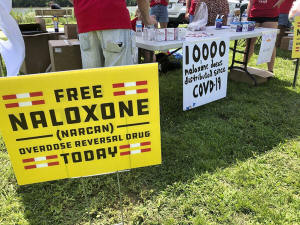West Virginia court declines to answer whether opioids distribution can
cause public nuisance
[May 13, 2025]
By JOHN RABY
CHARLESTON, W.Va. (AP) — West Virginia's Supreme Court on Monday
declined to answer a federal court's question in an appeal in a landmark
lawsuit over whether the distribution of opioids can cause a public
nuisance.
The 3-2 opinion returns the case to the 4th U.S. Circuit Court of
Appeals in Richmond, Virginia.
It's been nearly three years since a federal judge in Charleston ruled
in favor of three major U.S. drug distributors who were accused by
Cabell County and the city of Huntington of causing a public health
crisis by distributing 81 million pills over eight years in the county.
AmerisourceBergen Drug Co., Cardinal Health Inc. and McKesson Corp. also
were accused of ignoring the signs that Cabell County was being ravaged
by addiction.
U.S. District Judge David Faber in Charleston said West Virginia’s
Supreme Court had only applied public nuisance law in the context of
conduct that interferes with public property or resources. He said to
extend the law to cover the marketing and sale of opioids “is
inconsistent with the history and traditional notions of nuisance.”
Last year the appeals court in Richmond, Virginia, sent a certified
question to the state Supreme Court, which states: “Under West
Virginia’s common law, can conditions caused by the distribution of a
controlled substance constitute a public nuisance and, if so, what are
the elements of such a public nuisance claim?”
Had the state justices ruled that opioids distribution can cause a
public nuisance, the case would have returned to the 4th Circuit anyway.
Had the West Virginia court found that opioids can’t cause a public
nuisance, the appeal would have ended, the 4th Circuit has said.

Instead, a majority of the West Virginia justices refused to get
involved.
Justice Haley Bunn delivered the opinion of the West Virginia Supreme
Court. Justice Beth Walker, who is retiring next month, issued a
separate opinion. Chief Justice Bill Wooton was joined in a dissenting
opinion by Circuit Judge Tera Salango. Salango and Circuit Judge Andrew
Dimlich heard the case on temporary assignment after two other justices
disqualified themselves.
Paul Farrell Jr., an attorney representing the plaintiffs, said Monday
he was disappointed that the justices declined to answer the legal
question.
“The fight isn’t over," Farrell said. "There’s still a long way to go.
We continue on our path to seek justice.”

[to top of second column]
|

Signs are displayed at a tent during a health event on June
26, 2021, in Charleston, W.Va. (AP Photo/John Raby, File)
 Farrell said the appeals court still
must address a combination of factual and legal issues.
A Cardinal Health spokesperson declined to comment on Monday’s
ruling. Emails seeking comment from AmerisourceBergen and McKesson
weren’t immediately returned.
During arguments earlier this year before the state Supreme Court
over the certified question, Steve Ruby, an attorney for the
companies, called the plaintiffs’ arguments to grant the public
nuisance “radical” and that, if granted, it would “create an
avalanche of activist litigation.”
Thousands of state and local governments have sued over the toll of
opioids. The suits relied heavily on claims that the companies
created a public nuisance by failing to monitor where the powerful
prescriptions were ending up. Most of the lawsuits were settled as
part of a series of nationwide deals that could be worth more than
$50 billion. But there wasn’t a decisive trend in the outcomes of
those that have gone to trial.
The appeals court had noted that the West Virginia Mass Litigation
Panel, which works to resolve complex cases in state court, has
concluded in several instances that opioid distribution “can form
the basis of a public nuisance claim under West Virginia common
law.”
In his 2022 decision, Faber also said the plaintiffs offered no
evidence that the defendants distributed controlled substances to
any entity that didn’t hold a proper registration from the U.S. Drug
Enforcement Administration or the state Board of Pharmacy. The
defendants also had suspicious monitoring systems in place as
required by the Controlled Substances Act, he said.
In 2021 in Cabell County, an Ohio River county of 93,000 residents,
there were 1,059 emergency responses to suspected overdoses —
significantly higher than each of the previous three years — with at
least 162 deaths.
The plaintiffs had sought more than $2.5 billion that would have
gone toward opioid use prevention, treatment and education over 15
years.
All contents © copyright 2025 Associated Press. All rights reserved |